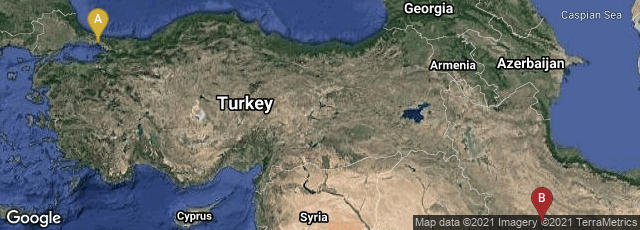
A: İstanbul, Turkey, B: Hamedan, Hamadan Province, Iran
"The conversion of Ghazan Khan to Islam", Timurid manuscript, Bibliothèque nationale de France, Supplément persan 1113, c. 1430.
In 1307 Persian physician of Jewish origin, polymathic writer and historian from Hamadan, Rashīd al-Dīn Tabīb (Persian: رشیدالدین طبیب) also Rashīd al-Dīn Fadhl-allāh Hamadānī (Persian: رشیدالدین فضلالله همدانی), a convert to Islam, wrote in the Persian language a history, very long for the time, entitled Jami al-Tawarikh.
"It was in three volumes with a total of approximately 400 pages, with versions in Persian, Arabic and Mongol. The work describes cultures and major events in world history from China to Europe; in addition, it covers Mongol history, as a way of establishing their cultural legacy. The lavish illustrations and calligraphy required the efforts of hundreds of scribes and artists, with the intent that two new copies (one in Persian, and one in Arabic) would be created each year and distributed to schools and cities around the Ilkhanate, in the Middle East, Central Asia, Asia Minor, and the Indian sub-continent. Approximately 20 illustrated copies were made of the work during Rashid al-Din's lifetime, but only a few portions remain, and the complete text has not survived. The oldest known copy is an Arabic version, of which half has been lost, but one set of pages is currently in the Khalili Collection, comprising 59 folios from the second volume of the work. Another set of pages, with 151 folios from the same volume, is owned by the Edinburgh University Library. Two Persian copies from the first generation of manuscripts survive in the Topkapi Palace Library in Istanbul. The early illustrated manuscripts together represent 'one of the most important surviving examples of Ilkhanid art in any medium' and are the largest surviving body of early examples of the Persian miniature"( Wikipedia article on Jami al-Tawarikh, accessed 01-25-2012).
This history contained a discussion of printing in China. The description of the printing process bears very strong resemblance to the processes used in the large printing ventures in China under Feng Dao (932–953):
"This is the earliest notice of Chinese printing, aside from the making of paper money, outside of East Asiatic sources. It is evident that Rashid had a reasonably reliable source of information and that the printing in which he was interested was the printing of books, especially historical records. Where he failed was in not grasping the importance of the new art as an economical means of disseminating literature and in seeing it merely as a means of authenticating the exact text—a characteristic of Chinese official printing that has already been noticed . . . ." (Carter, Invention of Printing in China 2nd ed[1955] 173).
In 1980, a 120-page illuminated version of Rashīd al-Dīn's manuscript in Arabic was sold at Sotheby's to Nasser David Khalili of London for £850,000, then the highest price ever paid for an Arabic manuscript. In August 2014 an extensive description of Khalili manuscript was available from Saudi Aramco World at this link.
♦ Also in August 2014 a digital facsimile of the Jami al-Twarikh of Rashid al-Din in Edinburgh University Library, which was considered another portion of the identical manuscript from which the Khalili portion originated, was available from Edinburgh University Library at this link. The Edinburgh portion was collected by Colonel John Baillie and donated to Edinburgh University in 1876.